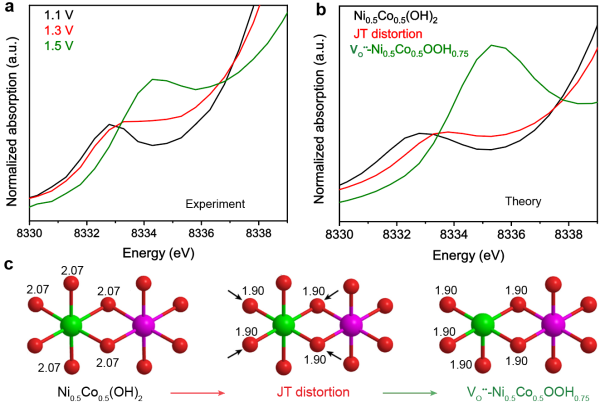A research team led by Prof. TANG Zhiyong from the National Center for Nanoscience and Technology (NCNST), and his collaborators discovered the high activity origin of oxygen evolution reaction in metal-organic frameworks. Accordingly, the designed Ni0.9Fe0.1-MOF displays an extremely low overpotential of 198 mV and 231 mV at 10 mA cm-2 and 20 mA cm-2, respectively. This study was published in Nature Energy.
Metal-organic frameworks (MOFs) have emerged as a new type of heterogeneous catalysts with rich composition, periodical arrangement and high porosity. They exhibite great activity in many reactions including electrocatalytic oxygen evolution reaction (OER). So far, their structure-performance relationships, especially those regarding the reconstruction and role of active species, remain unexplored, which cast serious doubt on the catalytic activity origin of MOFs.
In this work, operando X-ray absorption spectroscopy and high-resolution transmission electron microscopy imaging are employed. Researchers reveal a full landscape of the biphasic structural transformation occurring at the nodes inside Ni and Co bimetallic MOF during OER (Figure 1). Notably, this potential-induced two-step reconstruction is completely different from the reported one-step surface reconstruction in traditional catalysts.

Figure 1. Quantitative atomic structure evolution under operando condition
In addition, a series of operando advanced characterization techniques and computation calculations are employed to determine the highly active species during OER. The simultaneous correlation between the molecular structural revolution and the generated OER current discloses the origin of high oxygen evolution activity. The crystal orbital Hamilton population bonding analysis reveals that the in-situ formed oxygen-vacant oxyhydroxide from the hydroxide via Jahn-Teller distortion is the genuine origin. Particularly, the transition from hydroxide to oxyhydroxide at Ni and Co nodes can be synchronous by altering the metal ratio in NiCo-MOFs, leading to the best OER activity.
Moreover, the same phenomenon can be observed in various MOF-based materials such as Ni-MOF, Fe-MOF, NiFe-MOF, Co-MOF and NiCo-MOFThese findings not only offer deep insight in designing highly active OER catalysts, but also lay the foundation to precisely elucidate the activity origin of MOFs and other catalysts.
This work was supported by the National Natural Science Foundation of China, Strategic Priority Research Program of Chinese Academy of Sciences, Frontier Science Key Project of Chinese Academy of Sciences, K.C.Wong Education Foundation and National Key Basic Research Program of China.




